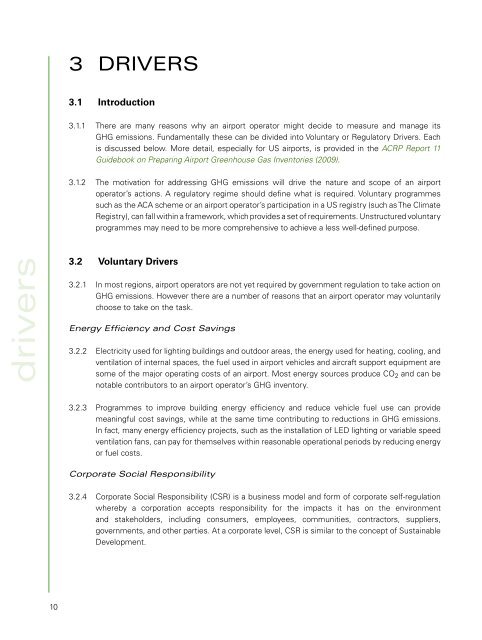Airport Greenhouse Gas Emissions Management - Zurich Airport
Airport Greenhouse Gas Emissions Management - Zurich Airport
Airport Greenhouse Gas Emissions Management - Zurich Airport
You also want an ePaper? Increase the reach of your titles
YUMPU automatically turns print PDFs into web optimized ePapers that Google loves.
3 DRIVERS<br />
3.1 Introduction<br />
3.1.1 There are many reasons why an airport operator might decide to measure and manage its<br />
GHG emissions. Fundamentally these can be divided into Voluntary or Regulatory Drivers. Each<br />
is discussed below. More detail, especially for US airports, is provided in the ACRP Report 11<br />
Guidebook on Preparing <strong>Airport</strong> <strong>Greenhouse</strong> <strong>Gas</strong> Inventories (2009).<br />
3.1.2 The motivation for addressing GHG emissions will drive the nature and scope of an airport<br />
operator’s actions. A regulatory regime should define what is required. Voluntary programmes<br />
such as the ACA scheme or an airport operator’s participation in a US registry (such as The Climate<br />
Registry), can fall within a framework, which provides a set of requirements. Unstructured voluntary<br />
programmes may need to be more comprehensive to achieve a less well-defined purpose.<br />
drivers<br />
3.2 Voluntary Drivers<br />
3.2.1 In most regions, airport operators are not yet required by government regulation to take action on<br />
GHG emissions. However there are a number of reasons that an airport operator may voluntarily<br />
choose to take on the task.<br />
Energy Efficiency and Cost Savings<br />
3.2.2 Electricity used for lighting buildings and outdoor areas, the energy used for heating, cooling, and<br />
ventilation of internal spaces, the fuel used in airport vehicles and aircraft support equipment are<br />
some of the major operating costs of an airport. Most energy sources produce CO 2 and can be<br />
notable contributors to an airport operator’s GHG inventory.<br />
3.2.3 Programmes to improve building energy efficiency and reduce vehicle fuel use can provide<br />
meaningful cost savings, while at the same time contributing to reductions in GHG emissions.<br />
In fact, many energy efficiency projects, such as the installation of LED lighting or variable speed<br />
ventilation fans, can pay for themselves within reasonable operational periods by reducing energy<br />
or fuel costs.<br />
Corporate Social Responsibility<br />
3.2.4 Corporate Social Responsibility (CSR) is a business model and form of corporate self-regulation<br />
whereby a corporation accepts responsibility for the impacts it has on the environment<br />
and stakeholders, including consumers, employees, communities, contractors, suppliers,<br />
governments, and other parties. At a corporate level, CSR is similar to the concept of Sustainable<br />
Development.<br />
10

















